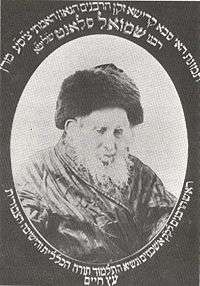Shmuel Salant

Shmuel Salant (Hebrew: שמואל סלנט; January 2, 1816 – August 16, 1909) served as the Ashkenazi Chief Rabbi of Jerusalem for almost 70 years. He was a renowned Talmudist and Torah scholar.
Biography
He was born in Białystok, then part of Russia. After marrying Toiva (Yonah), the eldest daughter of Rabbi Yosef Zundel of Salant, he adopted his father-in-law's surname. At an early age his lungs became damaged, and he was advised to seek a warm climate. This induced him in 1840 to go with his wife and son Binyomin Beinish to Jerusalem.[1]
En route, in Constantinople, he met and gained the friendship of Sir Moses Montefiore, then on his way to defend the Jews falsely accused in the Damascus Blood Libel. Salant arrived in Jerusalem in 1841, rejoining his father-in-law and about 500 other Ashkenazim who had preceded him. From 1848 to 1851 he served as a meshulach (fund-raiser), visiting the principal cities of Lithuania and Poland to collect money for the impoverished Jews of the Old Yishuv. This age-old practice was termed the Chaluka.
In 1860, Salant travelled to Germany, Amsterdam, and London to collect funds. Upon his return to Jerusalem, he succeeded in ensuring that his contributions were equally divided between the Sephardim and Ashkenazim. He also collected donations for the building of the Beis Yaakov Synagogue in Jerusalem. In 1871 he succeeded Rabbi Meir Auerbach as chief rabbi of the Ashkenazim.[1]
In 1860, a time of universal poverty and hardship, Salant founded the Rabbi Meir Baal Haneis Salant charity to provide for all of Israel's poor and impoverished, Sefardi and Ashkenazi alike. In 1888 Salant's eyesight began to fail, and a few years later he became blind. This did not stop his extensive activity in communal affairs. In 1900, however, Salant requested an assistant. Rabbi Eliyahu David Rabinowitz-Teomim, a world-renowned rabbi and author, had just arrived in Israel from Russia. He was immediately selected for the position. However, Rabinowitz-Teomim predeceased Salant in 1905.
Rabbis Salant and Auerbach highly supported that the Balady citron which was cultivated at the Arabic village of Um el-Faum, was the most kosher to be used as etrog in the four species during the festival of sukkot. .[2]
Salant did not author any major works, but was regarded as a distinguished Talmudist and an excellent and learned leader. Many of halachic (legal) positions are known through the prodigious writing of his student and grandson by marriage, Rabbi Yechiel Michel Tukichinsky.
He was also known for his moderation and tolerance of all classes of Jews. As Ashkenazic chief rabbi, he was on friendly terms with his Sephardic counterpart, Chief Rabbi Yaakov Shaul Elyashar, and they generally acted in harmony concerning the welfare matters of the community.
Salant was instrumental in the establishment of the Etz Chaim Yeshiva in Jerusalem. He also helped found Bikur Cholim Hospital and encouraged people to move into new neighborhoods outside of the Old City walls. During his tenure as chief rabbi, the population of Jerusalem grew from 5,000 to 30,000 Jews.
Salant died on Monday, 16 August 1909 (29 Av 5669), and was buried on the Mount of Olives. His student, Rabbi Yechiel Michel Tukichinsky writes that though funerals in Jerusalem are generally performed within the same day or night as the passing, Salant's was an exception. He died at night and the funeral was not held until daybreak because the Rabbis were concerned that the massive attendance to a nighttime funeral procession would lead to injuries or worse. In 2006, Salant was memorialized in an Israeli postage stamp, pictured.
Salant's memory was invoked during the 2011 political lobbying of his direct relative, New York State Senator Stephen Saland, by local chareidi Agudah leadership in opposition to legalization of same sex marriage and the Marriage Equality Act.[3]
References
- 1 2 "Chief Rabbi Salant Dies in Jerusalem". The New York Times. 17 August 1909. Retrieved 30 November 2011.
- ↑ Kuntres Pri Etz Hadar (Jerusalem תרל"ח)
- ↑ Hoffman, Allison (June 17, 2011). "Jewish Lawmaker Key to N.Y. Marriage Bill: Scion of prominent rabbinic family has been lobbied by ultra-Orthodox". Tablet Magazine. Archived from the original on June 24, 2011.
But he is, according to people familiar with the Agudath campaign, directly related to Shmuel Salant, a prominent rabbi of the late 19th century who served as the Ashkenazic Chief Rabbi of Jerusalem until his death in 1909. The Agudath has, accordingly, sweetened its appeals with references to the lawmaker’s family tree—and some enthusiastic supporters in Jerusalem are rumored to have gone so far as to have prayed at Salant’s grave in hopes of his intercession in the matter.
![]() This article incorporates text from a publication now in the public domain: Singer, Isidore; et al., eds. (1901–1906). "Salant, Samuel". Jewish Encyclopedia. New York: Funk & Wagnalls Company.
This article incorporates text from a publication now in the public domain: Singer, Isidore; et al., eds. (1901–1906). "Salant, Samuel". Jewish Encyclopedia. New York: Funk & Wagnalls Company.
External links
- Rabbi Meir Baal Haneis Salant charity
- Chief Rabbi Salant Solicits Funds for Yeshiva 'Etz Hachaim' and 'Bikur Holim' Hospital Shapell Manuscript Foundation